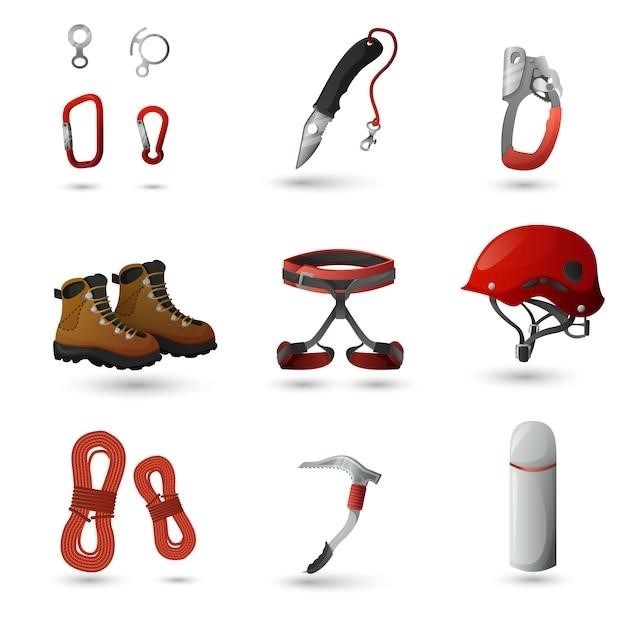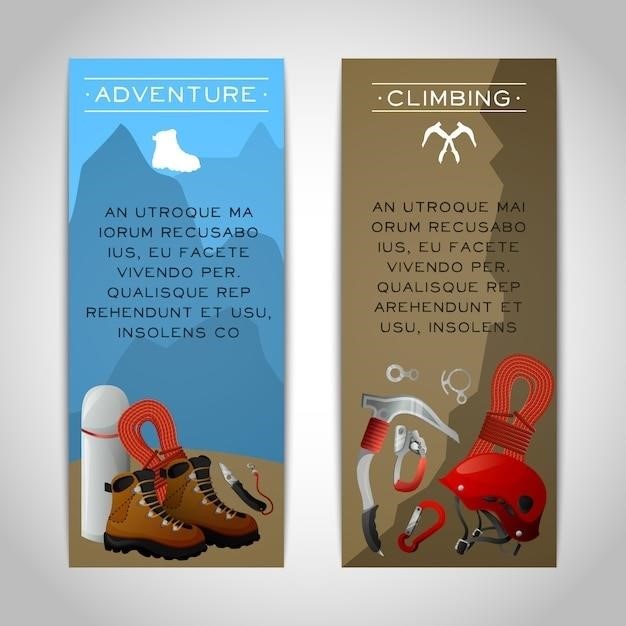Rock Climbing Shoe Size Guide⁚ Finding the Perfect Fit
Finding the perfect fit in rock climbing shoes is crucial for comfort and performance․ Shoe sizing varies significantly across brands and models․ Consider your climbing style‚ foot shape‚ and desired fit (comfort vs․ performance) when choosing a size․ Utilize online resources and brand-specific sizing charts for accurate measurements and guidance․
Understanding Your Foot Size
Accurately measuring your feet is the foundational step in finding the right climbing shoe size․ Begin by tracing your foot onto a piece of paper‚ ensuring your weight is evenly distributed․ Measure the length from your heel to your longest toe․ Note that feet can vary slightly in size‚ so measure both feet and use the larger measurement․ Consider your foot width as well; some brands offer narrow‚ medium‚ or wide options․ Understanding your foot’s arch type can also be beneficial; high arches may require different considerations than low arches․ Remember that climbing shoes are designed to fit snugly‚ potentially smaller than your street shoe size․ This snug fit is crucial for performance‚ but excessive tightness can lead to discomfort and injury․ Take your time‚ and be precise with your measurements; this will help narrow down your options significantly when browsing various brands and models․

Brand-Specific Sizing Charts
A critical aspect of finding your ideal climbing shoe size lies in understanding that sizing varies considerably among brands․ What constitutes a US men’s 9 in one brand might be equivalent to a US men’s 8․5 or even a US men’s 10 in another․ This inconsistency stems from differing manufacturing processes‚ last shapes (the molds used to create the shoes)‚ and material properties․ Therefore‚ relying solely on your street shoe size is insufficient; always consult the manufacturer’s specific size chart for the model you’re interested in․ These charts often provide conversions between US‚ UK‚ and European sizes‚ sometimes including additional information on volume or fit․ Pay close attention to any notes or explanations provided by the brand regarding their sizing philosophy․ Some brands may run consistently smaller or larger than others‚ and even within a single brand‚ different models can have varying fits․ Don’t hesitate to cross-reference information from multiple sources or reviews to gain a more comprehensive understanding of a particular brand’s sizing․
Different Fit Preferences⁚ Comfort vs․ Performance
The choice between comfort and performance in rock climbing shoes often involves a trade-off․ A comfortable fit prioritizes ease and reduces the risk of discomfort during long climbs or extended periods of wear․ This generally means selecting a size closer to your street shoe size‚ allowing for ample toe space and reduced pressure points․ Conversely‚ a performance fit emphasizes sensitivity and precision on the rock face․ Climbers often opt for a tighter fit‚ sometimes downsizing by half a size or even a full size from their street shoe size․ This snug fit enhances foot control and allows for more precise edging and smearing techniques․ The level of tightness is subjective and depends on individual preferences and climbing style․ Beginners might prioritize comfort to build confidence and avoid injury‚ while experienced climbers might prefer a more aggressive fit for enhanced performance in challenging climbs․ Ultimately‚ the optimal fit balances comfort with the ability to perform efficiently and maintain control on the rock․ Experimentation and trying on multiple sizes are key to finding the right balance․
Measuring Your Feet Accurately
Accurate foot measurement is fundamental to selecting the right rock climbing shoe size․ Begin by tracing the outline of your foot on a piece of paper‚ ensuring your weight is evenly distributed and your heel is firmly against a wall․ Use a ruler to measure the length from the furthest point of your heel to the tip of your longest toe․ Repeat this process for both feet‚ as they may differ slightly in size․ Select the larger measurement as your guide․ Consider the width of your foot as well; some climbing shoes offer varying volume options (low‚ medium‚ high)․ A narrow foot might find a low-volume shoe more comfortable‚ while a wider foot may require a higher-volume option․ Note that these measurements are only a starting point․ Most importantly‚ try on multiple sizes and styles before purchasing․ Even with precise measurements‚ personal preferences and the specific characteristics of different shoe models will impact the ideal fit․ The feel of the shoe on your foot is the ultimate determinant of the correct size‚ so prioritize in-person fitting whenever possible․
Considering Shoe Volume and Shape
Beyond length‚ the volume and shape of a climbing shoe significantly influence the fit․ Volume refers to the amount of space inside the shoe; Low-volume shoes are snug and precise‚ ideal for performance climbing where sensitivity is key․ High-volume shoes offer more space‚ better accommodating wider feet or those preferring a more comfortable fit․ The shape of the shoe also matters․ Some shoes have a downturned toe‚ which enhances performance on smaller holds but may cause discomfort for extended periods․ Others feature a flatter profile‚ prioritizing comfort and all-day wear․ Consider your foot shape⁚ narrow feet may benefit from a snug‚ low-volume shoe with a slight downturn‚ whereas wider feet might require a higher-volume‚ flatter option․ Different brands offer various lasts (shoe molds) resulting in unique shapes․ Experimenting with different brands and models allows you to discover which shoe shape complements your foot best․ Don’t solely rely on size charts; the actual feel of the shoe on your foot‚ considering both volume and shape‚ is paramount in determining the ideal fit for your climbing style and comfort preferences․
Adjusting for Different Climbing Styles

Your climbing style significantly impacts the ideal climbing shoe fit․ Sport climbers‚ who often encounter less strenuous routes with larger holds‚ might prioritize comfort․ A slightly looser fit allows for longer periods of climbing without excessive discomfort․ Bouldering‚ characterized by short‚ intense sequences on smaller holds‚ demands precision and sensitivity․ Bouldering shoes typically fit snugly‚ almost painfully tight‚ maximizing toe power and feel․ Traditional climbers‚ navigating varied terrain and often using aid‚ might value a balance between comfort and performance․ A slightly less aggressive fit offers enough precision while minimizing discomfort during longer climbs; Lead climbers‚ facing more technical challenges‚ often prefer a slightly tighter fit‚ enhancing precision and sensitivity on smaller holds․ The choice between a snug‚ performance-oriented fit and a more comfortable‚ less restrictive fit depends entirely on your climbing style and individual preferences․ Experimentation and considering the demands of your preferred climbing discipline are crucial for finding the optimal shoe fit․
Children’s Climbing Shoe Sizing
Children’s feet grow rapidly‚ making shoe selection crucial․ Unlike adults‚ children’s climbing shoes should not fit as tightly․ A slightly larger size accommodates growth and prevents discomfort․ Prioritize comfort over aggressive fit; a snug but not constricting fit is ideal․ Consider your child’s climbing experience․ Beginners may benefit from a roomier fit promoting comfort and confidence․ More experienced young climbers‚ who might want a more precise fit‚ can still tolerate slightly more space․ Regularly check for proper fit as feet grow quickly․ Consider purchasing shoes with adjustable closures like Velcro straps for better adaptability․ Renting shoes at a gym is suitable for infrequent climbers; however‚ owning personal shoes ensures hygiene and a proper fit tailored to your child’s feet․ Remember‚ a happy and comfortable child climber is a safer and more confident one․ Prioritize their comfort and allow for growth; it is better to have a slightly larger shoe than one too small and painful․ Observe your child’s comfort level during and after climbing․
Dealing with Size Variations Across Brands
Rock climbing shoe sizing inconsistencies across brands are common․ A size 9 in one brand might feel significantly different from a size 9 in another․ This stems from variations in manufacturing processes‚ last shapes (the mold used to shape the shoe)‚ and materials․ Some brands‚ like La Sportiva‚ tend to run smaller than others‚ often requiring a 1․5 to 2 size reduction from street shoe size․ Conversely‚ brands such as Black Diamond shoes often run closer to street shoe sizing․ Even within a single brand‚ different models may have varied sizing․ A shoe designed for aggressive climbing will likely fit tighter than a comfort-oriented model‚ even at the same labeled size․ The best approach is to consult each brand’s specific size chart․ Pay close attention to the manufacturer’s recommendations and consider user reviews mentioning the fit and sizing of specific models․ If possible‚ try shoes on before purchasing․ If trying on isn’t an option‚ order from retailers with generous return policies‚ allowing for exchanges if the initial size isn’t ideal․ Don’t solely rely on numerical size; carefully compare measurements and fit descriptions․
Using Online Resources and Size Charts
Many online resources and brand websites provide detailed rock climbing shoe size charts․ These charts typically correlate street shoe sizes (US‚ UK‚ EU) with climbing shoe sizes for various models․ Before purchasing‚ always consult the specific manufacturer’s size chart for the model you’re interested in․ Pay close attention to any notes on fit‚ volume‚ or specific model variations․ Some brands offer detailed explanations of their sizing systems and provide conversion charts between different sizing standards․ Online forums and review sites can offer valuable insights into the sizing and fit of particular models․ Reading user reviews can provide real-world perspectives on how a shoe fits compared to its listed size․ Look for comments on whether a shoe runs true to size‚ larger‚ or smaller than expected․ Combine this information with the manufacturer’s chart for a more comprehensive understanding․ Remember‚ individual foot shapes and preferences vary‚ so while these resources are helpful‚ they may not guarantee a perfect fit for everyone․ Ultimately‚ trying on shoes before buying is the most reliable method to determine the optimal size and fit․